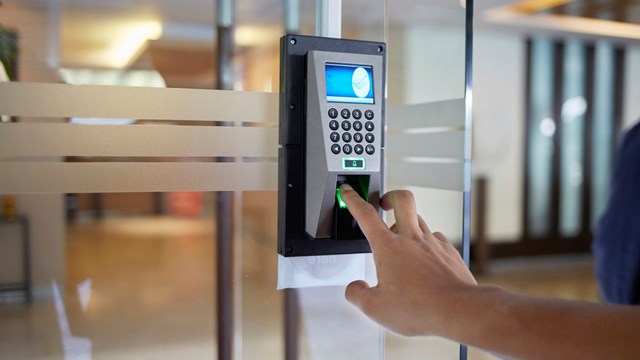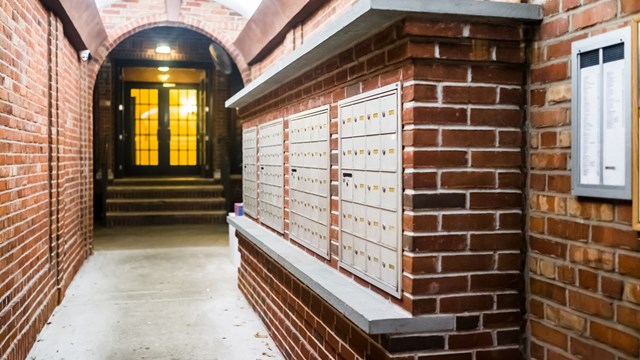
‘Tis the season for visitors, packages, and festive gatherings. Along with the good cheer, the end-of-year flurry of activity also highlights the challenges of keeping multifamily buildings and their residents safe and secure.
In addition to the regular stream of residents, visitors, property management staff, contractors, maintenance workers, and delivery personnel, even more people pass through buildings and HOAs during the holidays. Add in year-end repair projects and mandatory inspections, and you’ve got one busy building.
A truly secure building controls and monitors access for vendors, residents, and guests, making sure nobody gets in without prior authorization. Simply being aware of who has access to the building is a great first step in managing security. Residents can help by taking small steps—not buzzing in strangers or holding doors open for people they don’t know, letting property managers know ahead of time if they have visitors scheduled, and retrieving packages so they don’t sit for long periods in the lobby or package area, to name just a few examples.
The Challenge
Verifying and tracking outside visitors and personnel in a building or HOA requires the property’s staff to have a coordinated protocol in place for doing that. “Tenants will usually reach out to management to say they will have a visitor, whether it’s a service, guest, or moving company,” says Ernest Rrika, director of operations at property management firm Peninsula Property Management in New York City. “We want to make sure this information aligns so everyone who is in the building is authorized to be there.” Of course, the larger the building, the greater the challenge.
“We log in whoever comes in and out of the building so we can anticipate traffic,” says Rrika. “We make sure everyone is registered with the building and management, and we train our staff at the front desk using a checklist in case anything goes wrong. It comes down to documenting and having a plan in place.”
“Can you imagine how many people come in and out of a 100-unit building?” says Allan Liers, president of Metro Security Experts, a New York-based company that specializes in residential security. “It’s a huge operational challenge due to the amount of staff time it requires, and it raises security concerns. We need to know exactly who is coming into the building.”
Boxes, Boxes Everywhere
The sheer volume of package deliveries—which had been on a steady upward trajectory for years before the pandemic of 2020 truly opened the floodgates—creates a unique security concern, both in terms of strangers accessing properties, and in keeping track of and storing packages. Lanni notes that package deliveries and handling increase the strain on existing resources, and may lead to the potential neglect of more traditional security-related responsibilities. When considering how to manage this, Rrika suggests designating a specific package room or other safe location, preferably with keypad access. “If you have a separate space, you can mitigate any problems by only allowing authorized individuals. You can also send reminders to residents letting them know they need to pick up packages,” he says.
“Package deliveries and moves are major,” says Christopher Lanni, principal and founder of Massachusetts-based independent security consulting firm Secure Residential Services. “Buildings are set up to receive moves, but not every building is designed perfectly. You have to look at physical controls–allowing loading dock and receiving doors to remain open when needed without leaving the entire building exposed. Everything is negated if you leave the building wide open.” A comprehensive security plan also takes the building design, layout, and access points into account when determining how deliveries will be received, signed for, and stored for their recipients’ collection.
Technology Offers a Solution
Physical access control systems are a crucial layer of security, and include areas like managing access points, credentials (keycards, fobs, biometrics), and perimeter security. Today, security controls are moving away from hardware and towards software. “In the old days, you’d have hard-wired connections,” Liars says, “but now it’s more mobile. This helps make things easier, because software can notify residents on their phones that they have a package or food delivery that’s arrived. Property managers can notify tenants that visitors are in, and visitors can be pre-scheduled into the software. Reminders can be sent easily. The future is software.”
Liers notes that hardware is becoming obsolete: “You install [a hardwired system], and within five years it’s changed, and you can’t get parts anymore. It doesn’t make much business sense. Software is scalable; it can be upgraded and changed.” He goes on to say that software can also help detect ‘tailgating’—the act of one person closely following another into a building so as to avoid needing a key or other means of access. “Technology is helping solve security issues,” says Liers. Many software platforms allow multiple systems to be fed into a single interface, which can be used not just for recording data but also for tracking history and viewing trends.
AI is also starting to play a role in building security. “We will start seeing more AI-assistance at buildings to help call residents, call for maintenance, or desk concierge,” says Liers. “For instance, digital doormen will be assisting regular doormen.” Beyond automation, these tools save time. “It comes down to savings for properties,” he says, “If you think about it, if we can give someone back 15 minutes a day—that’s 65 hours a year. That equates to cost savings and better mental health, getting a little time back. If you have smart software that’s easy to use, it’s designed to help us spend more time on what matters and manage time better.”
As technology continues to advance, buildings also need to plan for online security. “There is physical security, and there are also cybersecurity challenges,” says Liers. “Buildings today collect a lot of data about tenants, and this data needs to be protected and encrypted. We need to remind residents about different types of cybersecurity attacks that can occur, like phishing attempts. Regular reminders about best practices to protect data, whether it’s on-site or in the cloud, are crucial. People who want to commit crimes are also getting more sophisticated, and online scam attacks can look very real, so you need to be extremely vigilant.”
Balancing Convenience & Security
While technology sets the foundation for security, the human component—residents, staff, visitors, and delivery personnel—greatly impacts the success of all security measures. Involving residents in security protocols creates a sense of shared responsibility. “I think having a process and procedure in place that works specifically for your building and makes sense for your site is the biggest thing,” notes Lanni, “as well as training to make sure everyone is aware of the protocol. If you have a process in place, but areas are not secure, it defeats everything you’re doing.”
Liers notes that residents need to be aware of and informed about their building’s protocol, because ultimately, education on best practices is the best way to get people onboard and make the rules stick. “We sometimes forget not to hold a door open for a stranger, but if we educate and remind people, they’ll think about it. Meetings specifically focused on addressing security concerns can help reinforce those ideas.”
Sharing connections through phone apps can help create a greater sense of community, according to Liers. “It can be as simple as sending little reminders to let people know their package has arrived, that a meeting is coming up, that an elevator might be out for service, or that a security reminder not to hold doors open for neighbors,” he notes.”Sharing information helps contribute to safety and security.”
Convenience also needs to be a consideration when weighing what makes sense from a security standpoint. “I think it goes back to making the process user-friendly and communicating. If you can get residents to understand why you have the process in place, it can work,” says Lanni, “It’s important to have a clearly communicated process.”
Each building is distinctive, and no matter what policies are decided, it is up to the building management and boards to make sure residents are educated about proper procedures. Lanni adds that rule enforcement is important, noting, “There has to be an incentive for residents to follow rules. The rules need to be reasonable and fair. Once the rules are communicated, it’s up to residents to follow them.”
Embracing a Secure Community
Lanni lays out access control in three clear parts: the procedural part, the technology, and the actions of individuals. “All three of those things have to work in the same direction, make sense, and be communicated clearly,” he says. “If you have a sign-in process and then you go to the sheet and can’t legibly read anyone’s name, or see where they’re going or what they’re doing, it’s not helpful information. If you can produce a list of who’s been in the building through a tracking system, key fob history, vendor sign-ins (you should have a complete list), that’s usually an indication of how complete a security program is.”
“You put measures in place and watch and monitor to see how it’s working,” Lanni continues. “Things change throughout the year, so you need to update your plan to make sure it still makes sense. You can always make adjustments. For example, if you change your physical space or how rooms are used, then it would change access control.”
There’s always a balance between privacy, protection, and security, according to Liers. “Some buildings have elderly tenants and younger tenants alike. Younger tenants tend to want convenience and technology, and older tenants may not know how to call an Uber or use technology fully. It’s new to people,” he says. “I think the pandemic helped change some of that. There may have been some resistance before, but during the pandemic, everyone had to get used to these online technologies. It forced people to embrace this type of technology a little more.”
Ultimately, the overall goal is to protect everyone in the building. By balancing convenience with community and security, residents can feel safe both in their building and online. “Building security doesn’t have to be hard,” says Lanni, “It simply involves implementing good security measures, and when laid out properly, security should feel easy.” Having consistent, clearly communicated security protocols in place keeps everyone involved in building safety all year long.
Kate Mattiace is the Associate Editor of CooperatorNews.









Leave a Comment